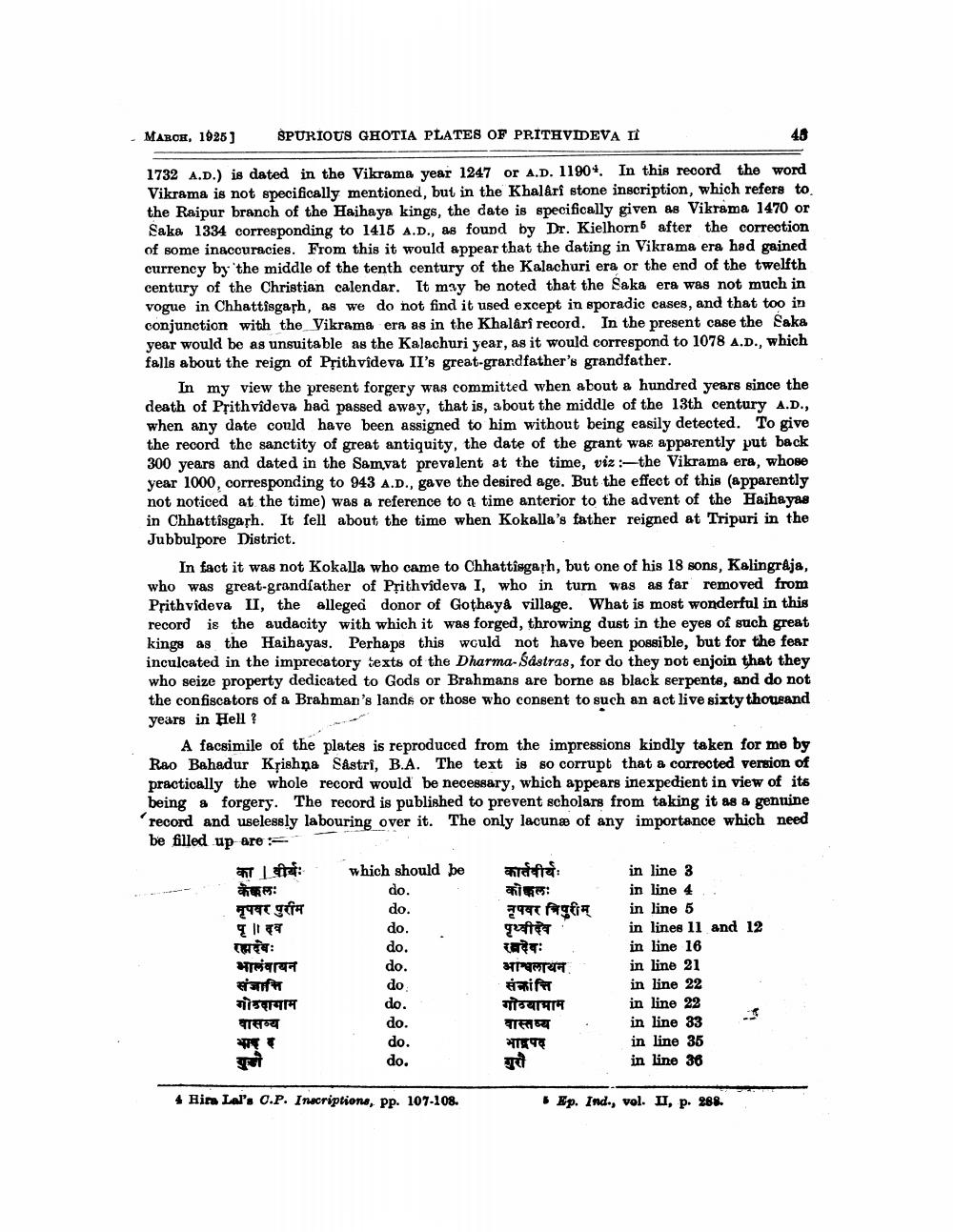________________
MARCH, 1925]
SPURIOUS GHOTIA PLATES OF PRITHVIDEVA II
48
1732 A.D.) is dated in the Vikrama year 1247 or A.D. 1190. In this record the word Vikrama is not specifically mentioned, but in the Khalârf stone inscription, which refers to the Raipur branch of the Haihaya kings, the date is specifically given as Vikrama 1470 or Saka 1334 corresponding to 1415 A.D., as found by Dr. Kielhorn after the correction of some inaccuracies. From this it would appear that the dating in Vikrama era had gained currency by the middle of the tenth century of the Kalachuri era or the end of the twelfth century of the Christian calendar. It may be noted that the Saka era was not much in vogue in Chhattisgarh, as we do not find it used except in sporadic cases, and that too in conjunction with the Vikrama era as in the Khalârî record. In the present case the Saka year would be as unsuitable as the Kalachuri year, as it would correspond to 1078 A.D., which falls about the reign of Prithvideva II's great-grandfather's grandfather.
In my view the present forgery was committed when about a hundred years since the death of Prithvideva had passed away, that is, about the middle of the 13th century A.D., when any date could have been assigned to him without being easily detected. To give the record the sanctity of great antiquity, the date of the grant was apparently put back 300 years and dated in the Samvat prevalent at the time, viz:-the Vikrama era, whose year 1000, corresponding to 943 A.D., gave the desired age. But the effect of this (apparently not noticed at the time) was a reference to a time anterior to the advent of the Haihayas in Chhattisgarh. It fell about the time when Kokalla's father reigned at Tripuri in the Jubbulpore District.
In fact it was not Kokalla who came to Chhattisgarh, but one of his 18 sons, Kalingråja, who was great-grandfather of Prithvideva I, who in turn was as far removed from Prithvideva II, the alleged donor of Gothaya village. What is most wonderful in this record is the audacity with which it was forged, throwing dust in the eyes of such great kings as the Haihayas. Perhaps this would not have been possible, but for the fear inculcated in the imprecatory texts of the Dharma-Sastras, for do they not enjoin that they who seize property dedicated to Gods or Brahmans are borne as black serpents, and do not the confiscators of a Brahman's lands or those who consent to such an act live sixty thousand years in Hell?
A facsimile of the plates is reproduced from the impressions kindly taken for me by Rao Bahadur Krishna Sastri, B.A. The text is so corrupt that a corrected version of practically the whole record would be necessary, which appears inexpedient in view of its being a forgery. The record is published to prevent scholars from taking it as a genuine record and uselessly labouring over it. The only lacunae of any importance which need be filled up are:=
ent Letter: केवलः नृपवर पुरीम पृ ॥ दव
रह्मदेवः
which should be do.
do.
do.
do.
do.
do
भालंवायन
संजाति
*3414
वासव्य
भाष द
get
4 Hira Lal's C.P. Inscriptions, pp. 107-108.
do.
do.
do.
do.
refre को फलः
नृपवर त्रिपुरी म् पृथ्वीदेव
रखदेवः
आश्वलायन
ifer गोठयामाम
वास्तव्य
भाद्रपद
गुरौ
in line 3
in line 4
in line 5
in lines 11 and 12
in line 16
in line 21
in line 22
in line 22
in line 33
in line 35
in line 36
Ep. Ind., vol. II, p. 288.




